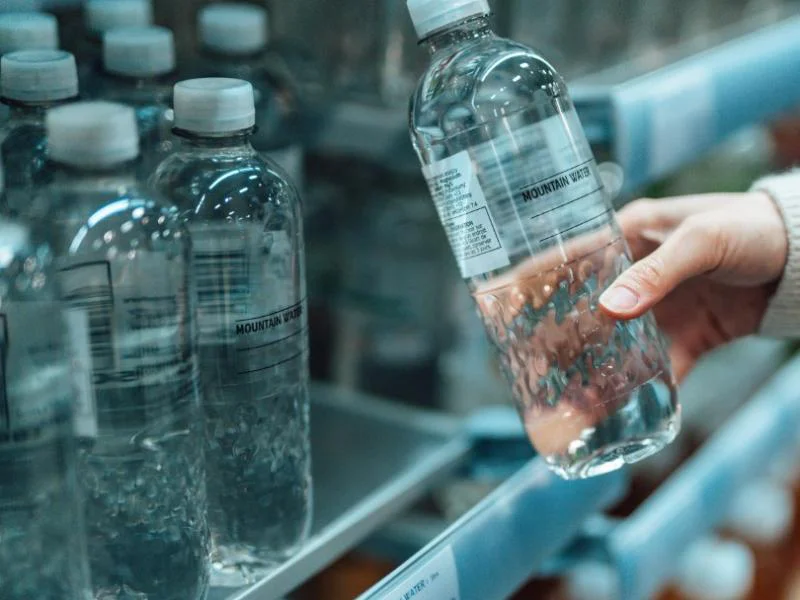Table water and spring water are different kinds of bottled water with their own qualities. Table water, also called purified or filtered water, comes from wells, springs, and municipal supplies, among other places. It goes through purification processes like reverse osmosis, distillation, or deionisation to eliminate impurities, minerals, and other contaminants. This gives it a consistent taste and quality. On the other hand, spring water comes from natural springs, where water from underground aquifers flows to the surface. Some of its natural minerals are still in it, which gives it a unique taste and mineral makeup. The only thing done to spring water is to eliminate harmful substances while keeping the water’s natural qualities.
What is Table Water?
Table water, also called purified or filtered water, is a type of bottled water that has been treated in many ways to get rid of impurities, contaminants, and minerals so that it meets standards for drinking water. It can be obtained from several places, including underground aquifers, surface water sources, and municipal systems. The main goal of treating table water is to make it safe to drink and give it a consistent taste and quality.
Table water goes through several purification steps, such as reverse osmosis, distillation, carbon filtration, or deionisation, to make it safe to drink. These methods can remove bacteria, viruses, chemicals, heavy metals, and organic compounds effectively. In some cases, table water may be re-mineralised to add certain minerals that make the water taste better and give it more health benefits.
Table water goes through strict quality checks and has to follow regulations set by groups like the Environmental Protection Agency (EPA) or the European Union (EU). These rules ensure the water is safe and up to human standards for quality and safety. In conclusion, table water is a popular choice because it is a reliable and consistent source of drinking water that is easy to get to.
What is Spring Water?
Spring water is bottled water from natural springs where water from underground aquifers flows to the surface. It is known for having a refreshing taste and a unique mix of minerals from the rock formations through which the water flows. These naturally occurring minerals give spring water its distinctive flavour and aroma and may even have some health advantages.
Unlike table water, spring water doesn’t get much treatment and keeps its natural minerals. The main goal of treatment is to get rid of contaminants like bacteria, viruses, and particles in suspension while keeping the water’s natural qualities. Filtration and treatment with ultraviolet (UV) light are often used to ensure spring water is safe to drink.
Organisations like the U.S. Environmental Protection Agency (EPA) or the European Union (EU) set rules for spring water to ensure it is safe and of good quality. These rules say spring water must stay true to its original source and makeup and be collected and moved cleanly.
Spring water is a natural, minimally processed alternative to other types of bottled water. It has a unique taste and may be suitable for your health because the minerals in it are still there.
Difference Between Table Water and Spring Water
The significant difference between spring water and table water is in the water’s mineral content, treatment methods, and point of origin. Both are consumable varieties of bottled water, but their unique qualities appeal to different demographics.
Natural springs are the source of spring water; these are points where water naturally emerges from subsurface aquifers due to geological processes. When the water travels through these geological features, it picks up a variety of minerals that enhance its flavour and may even have positive effects on health. Most pollutants, such as bacteria, viruses, and suspended particles, are removed from spring water during its basic treatment process. To make water safe for human consumption while still retaining its natural qualities, filtration and ultraviolet (UV) light treatment are frequently used. Hence, spring water’s quality, composition, and mineral content are unaltered from their initial state.
On the other hand, table water can come from various sources, such as wells, springs, rivers, or even municipal supplies. These are just a few of the potential sources. Its primary purpose is to offer stable flavour and quality. This is because the techniques used to purify table water, such as reverse osmosis, distillation, carbon filtration, and deionisation, are intensive. These processes are highly efficient at eradicating unwanted substances. It is possible to re-mineralise table water to improve its flavour and provide additional health advantages.
In conclusion, spring water is unfiltered and barely processed, so it retains its inherent mineral makeup, whereas table water is filtered and homogenised to ensure a uniform flavour and consistency. Individual preferences for taste, mineral content, and ease of preparation will ultimately dictate the preferred option.







